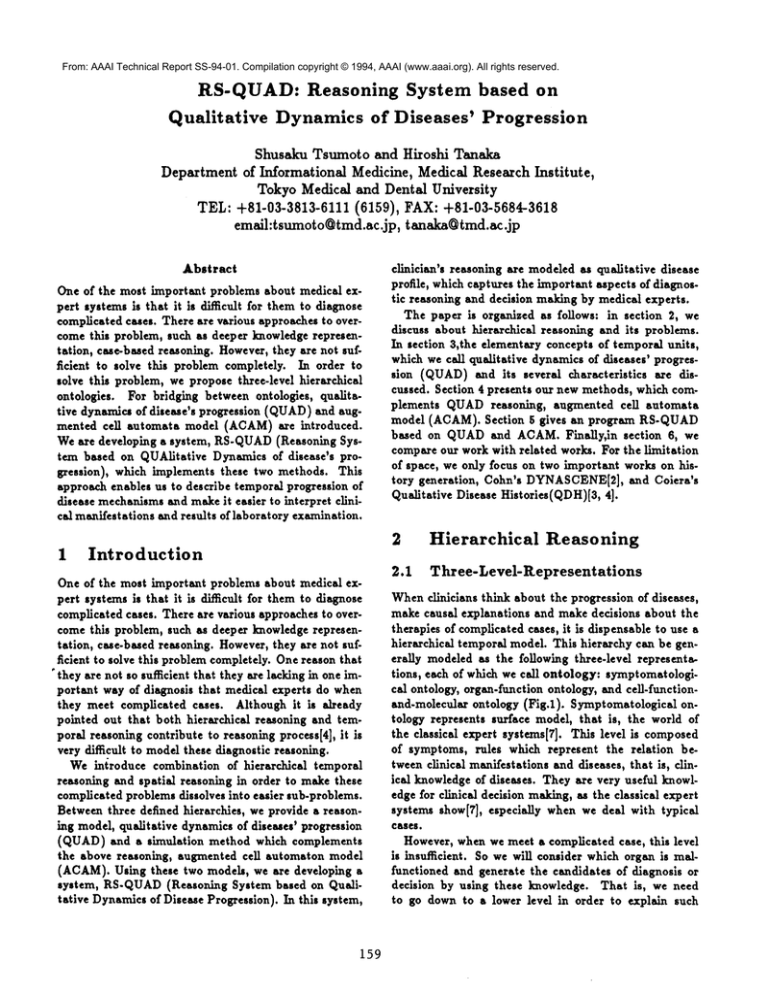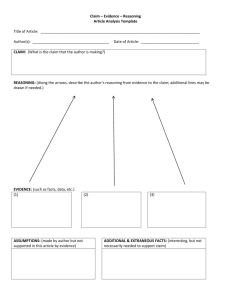
From: AAAI Technical Report SS-94-01. Compilation copyright © 1994, AAAI (www.aaai.org). All rights reserved.
RS-QUAD: Reasoning
Qualitative
Department
System
Dynamics of Diseases’
Abstract
One of the most important problems about medical expert systems is that it is difficult for them to diagnose
complicated cases. There are various approaches to overcome this problem, such as deeper knowledge representation, case-based reasoning. However, they are not sufficient to solve this problem completely. In order to
solve this problem, we propose three-level hierarchical
ontologies. For bridging between ontologles, qualitative dynsmics of disease’s progression (QUAD)and augmented ¢¢11 automata model (ACAM)are introduced.
Weare developing a system, RS-QUAD
(Reasoning System based on QUAlitative Dynamics of disease’s progression), which implements these two methods. This
approach enables us to describe temporal progression of
disease mechanismsend makeit easier to interpret clinlca] man}.festations and results of laboratory examination.
on
Progression
Shusaku Tsumoto and Hiroshi
Tanaka
of Informational
Medicine, Medical Research
Tokyo Medical and Dental University
TEL: +81-03-3813-6111
(6159),
emaihtsumoto@tmd.ac.jp,
1
based
Institute,
FAX: +81-03-5684-3618
tanaka@tmd.ac.jp
clinician’s reasoning are modeled as qualitative disease
profile, which captures the important aspects of diagnostic reasoning and decision making by medical experts.
The paper is organized as follows: in section 2, we
discuss about hierarchical reasoning and its problems.
In section 3,the elementary concepts of temporal units,
which we call qualitative dynamics of diseases’ progression (QUAD)and its severed characteristics
are discussed. Section 4 presents our new methods, which cornplements QUADreasoning,
augmented cell automata
model (ACAM). Section 5 gives an program RS-QUAD
based on QUADand ACAM.Finally, ln section 6, we
compare our work with related works. For the limitation
of space, we only focus on two important works on history generation, Cohn’s DYNASCENE[2],
and Colera’s
Qualitative Disease Historles(QDH)[3, 4].
2
Hierarchical
Reasoning
2.1
Three-Level-Representations
Introduction
One of the most important problems about medical expert systems is that it is dli~cult for them to diagnose
complicated cases. There are various approaches to overcome this problem, such as deeper knowledge representatlon, case-based reasoning. However, they are not sufficient to solve this problem completely. One reason that
"they are not so sufficient that they are lacklng in one iraportsnt way of diagnosis that medical experts do when
they meet complicated cases. Although it is already
pointed out that both hierarchical reasoning and ternporal reasoning contribute to reasoning process[4], it is
very dL’Hcult to model these diagnostic reasoning.
Weintroduce combination of hierarchical temporal
reasoning and spatial reasoning in order to make these
complicated problems dissolves into easier sub-problems.
Betweenthree defined hierarchies, we provide s reasoning model, qualitative dynamics of diseases’ progression
(QUAD) and a simulation method which complements
the above reasoning, augmented cell automaton model
(ACAM).Using these two models, we are developing
system, RS-QUAD(Reasoning System based on Qualitative Dynamicsof Disease Progression). In this system,
159
Whenclinicians think about the progression of diseases,
make causal explanations and make decisions about the
therapies of complicated cases, it is dispensable to use a
hierarchical temporal model. This hierarchy can be generally modeled as the following three-level representations, each of which we call ontology: symptomatologlca] ontology, organ.function ontology, and cell-functionand-molecular ontology (Fig.l). Symptomatologlca] ontulogy represents surface model, that is, the world of
the classical expert systems[7]. This level is composed
of symptoms, rules which represent the relation between clinical manifestations and diseases, that is, clinical knowledge of diseases. They are very useful knowledge for clinics] decision making, as the classics] expert
systems show[?], especially when we deal with typical
cases.
However, when we meet a complicated ease, this level
is insu~clent. So we will consider which organ is malfunctioned and generate the candidates of diagnosis or
decision by using these knowledge. That is, we need
to go down to a lower level in order to explain such
wcm~omatolo~|ca|ontoloay .....
surface model
push I t Pop’up
or ram function ontology ..... deep model
(macroscopic)
push
pop-up
cell function ad molecular ontology
--- deepermodel
(microscopic)
Figure I: Hierarchy of Temporal Units
complicated cases. This level is, what we call, a deeper
model. Thls model represents macroscopic pathophyslologlcal mechanisms, such as liver dysfunction, and renal
malfunction.
Whenthis level is insui~clent, we use the lowest model,
cell-function.and-molecular ontology, which is the world
of microscopic pathophyslologlcal level, such as cell damage, inflammation, dysplasia.
Note that we can add a model lower than molecular
ontology as our knowledge about diseases grows. We
define the molecular ontology as the lowest, since we
understand the mechanisms of diseases at the present
time by using that model as the lowest. However, in the
near future, we may do by using s level under the law of
quantum mechanics.
2.2
Three-Level-Ontologies
These different ontologles consist of different components, different constraints and different time scale. For
example, consider the mechanisms of Parkinson Disease,
whichis one of the most frequent neurological dlsesses[1].
Symptomatologically, this disease is described as famous
trias: tremor, akinesia, and masked face. Also we can
observe steppsge gait, the abnormalities of postured re"flex, etc. These symptomsprogress in the order of years,
and we say that the elinleal history of Parklnson disease
is "chronic progressive".
It is known that this mechanism is caused by the
atrophy of substantla nigra, in the macroscopic level.
And in the microscopic level, the degeneration of nlgra is observed. The time scale of this degeneration is
from months to years. So the pathophyslologicai mecha.
nisms of Parkinson disease are explained as follows: some
mechanism,such as mutation and storage of toxic agents,
triggers the degeneration of neurons in substantia nigra
slowly, and then, this causes the dysfunction of expyramidal motor system and finally, this causes the specific
symptoms of Parkinson Disease.
2.$
Problems of Hierarchical
Reasoning
These hierarchies are very useful to describe diseases and
explain the causality of the pathophyslological mecha.
nisms. However, there are several problems to use tese
hlerachies. First, it is uncertain howto choose an ontology in order to explain or describe diseases, what we
call ontoloi~ choice. As mentioned above, when physicians diagnose typical cases, they only deal with symptomatological ontology. However, when atypical cases or
complicated cases arc encountered, they go down to a
lower level. So we need to provide ontology-cholce rules
to deal with both cases.
Second, when going downto a lower ontological level
or going up to a higher level, we have to decompose
hlgher-level objects to lower ones or integrate lower-level
subjects into higher ones, respectively. Wecall this type
of reasoning bridging between ontologles.
For examples, in the case of Parklnson disease, degeneration of
neurons has to be integrated into atrophy of substantia
nlgra, which means malfunction of dopaminergic motor
system.
Third, Causal explanation or description ofdlseases by
using a hierarchy is incomplete. For the example shown
above, it is unknown why degeneration occurs or what
mechanism triggers such generation. It is also unknown
why malfunction of substantls algra, which is the result of degeneration, causes the above specific symptoms,
such as tremor. However, medical experts complements
these incomplete knowledge with their commonsenserea.
soning. So we have to represent these commonsenserea.
soning in order to supplement hlearchical models.
3
QUAD
One of the important concepts that medical experts
grasp is homeostasis. They consider a disease as s break
of homeostasis, which is the biological function to attain equUJbrinm between damage and compensation. A
certain factor causes damage of a function and compensation starts. If the function is not completely compensated, symptoms of malfunction begin to emerge. So,
there is some latency for symptoms to emerge from the
start point of damage. In the next subsection, we define
elementary concepts of QUAD.
8.1
Elementary
Concepts
We propose QUADto model the above temporal reasoning. Whenone function is damaged, compensatory
mechanism is triggered. If this mechanism can recover
the function up to normal range, symptoms will disappear. These steps can be shown in Fig.2. By using
this concept, we can define three elementary units to
represent temporal progression of clinical observstlons:
chronic progressive, paroxysmal(recurrent) and acute.
fun~ on
’I
~
symptoms latency
fI
l
J
symptom’speriod
"time
compensatory
period
Figure 2: Qualltatlve Dynmulcsof Diseases’ Progression
Note that,although c];nical courses are very complex,
they can represent the combination of these elementary
units. For exantple, a patient whosuffers from idiopathic
cardJomyopathyhas at first few symptomsin the subc];n]ca] stage because of compensatory mechanisms. Then
he complains of some specific symptoms, such as edema
and palpitation, when the damage cannot be fully compensated. The above course is chronic progressive. However, some disturbance occurs suddenly, and the compen.
satory mechanisms cannot solve this perturbation, some
severe symptoms, such as dyspnea and cyanosls, can be
observed acutely.
Three elementary units of qualitative dynamics can
be defined in terms of QUAD
as follows. First type ls a
chronic progressive type. Damageat each time point is
small, so compensation soon recover the loss of function
and no symptom can be observed only at that point.
But, we focus on longer tlme scale, functional damage
progresses slowly. Whenthe function is below the norreal range, symptomswill start. From tl~s temporal pattern, we can infer the pattern of prognosis; damage of
function is slowly increasing. Second type is a recurrent
type. Damagecontinues for some interval. After damage
starts,compensatory mechanism also starts. Tl~s mechanism makes the function return normal and then symptoms disappear. Even after symptoms disappear, equi.
];brinm between damage and compensation may persist.
Third type is a one shot attack. After one shot damage,
compensation starts slowly and after some period, the
function may recover. Thus using these kinds of pattern, we can represent temporal progression of diseases.
3.2
Disease Profile
Combining thls qualltatlve
dynamlcs as temporal descriptor with spatial descriptor, we can derive a quailtative sketch of a disease. Tl6s sketch represents a basic
161
part of pathophyslologlcal understanding of medical experts. Prom this sketch, with knowledge about the symptoms, symptornato]ogy, the occurrence of the symptoms,
we can derive the "disease profile" of the disease. This
profile reflects the process how medical experts under.
stand the disease.
For example, let us consider how Par]dnson disease
can be described in terms of these model. Some unknown mechanism triggers degeneration of neurons in
substantla nigra, which ls manlfested ms Le~#7/ bodT/in
the microscopic level. This degeneration is integrated
as damage of substantla nigra. This degeneration causes
compensatory mechanism, such as hypertropy of residual
active neurons. Both damage and compensation are very
slow, and the order of these mechanismis from months to
years. So no atrophic change of substantla nlgra cart be
observed at the beginning change. This is a subclinical
course of atrophy. Whencompensation mechan|sms cannot recover, atrophy will be observed. The same mechanlsm is observed at the bridging between organ-function
ontology and symptomatological one.
4
ACAM
The above reasoning, QUADmodels hierarchical ternporal reasoning. However, it lacks in capturing spatial
characteristics
of disease mechanism. As mentioned in
the above section, although we have to integrate the
damage of lower components into that of higher ones
or decompose the ms]functlon of higher components into
that of lower ones, howto do these procedures is unclear.
Surprisingly, medical experts easily reason such process by using their conuuonsense reasoning, which is
very d]fllcult to implement as an algorithm. Note that
this type of reasoning is closely related to the know1edge about tissues. For example, substantia nigra is a
collection of neurons. So function of substantia nigra is
derived by integration of function of each neurons. In
general, the number of these neurons is very large, and
they interact with each other. So this system can be
modeled as a large network of many particles wlth non];near interactlon[6]. Unfortunately, it is very dii~cnlt
to predict behavior of such a ]dnd of nonlinear network,
and the only way is to simulate such behavior using local
interaction model, such as cell automata method]6].
In order to implement this reasoning, we introduce
augmented cell automata model (ACAM), which provides ordinary cell automata model with some additional
conditions by applying the concept of Percolation]5]. For
example, we define cell potential in order to shuulate
hyperfunct]on which compensates by the loss of normal
cells. Probabllitles of cell damageis also defined to represent that the death of cell increases the probability of
deathof itsne|ghbors.
Using the results of simulation, we derive the potential
power of compensation and how organic function reacts
in the level of our defined symptomatological ontology
and his "scene" is closely connected with a surface model.
against damage chronologically. And also we derive the
conditions under which decompensatlon occurs.
5
6.2
RS-QUAD
Coiera’s
QDHs
Colera’s qualitative disease histories( QDH)[4] is very
similar to our QUAD.He points out clearly that deep
representations takes a computational cost and that a
intermediate representation between shallow and deep
saves this cost. ]~arthermore, he propose that QDHsare
good intermediate representations lying between shallow
disease patterns and deeper qualitative models. He also
class~es multi-level systems into two major categories,
hierarchies based on variable granularity and ones based
on variable representation type.
The main differences between Colera’s approach and
ours is the following two points. First, while his approach is oriented to variable representation type, ours is
to granularity. His deeper model is based on qualitative
model using the framework of QSIMand his qual]tatlve
superposition[3]. On the other hand, we apply qualite.
tire histories to bridging between ontologles. Concerning
with this granularity based system, Coiera[4] discusses
that one of the problem of hierarchies based on granularity is information lost from bottom to top, and this
is exactly what we mentioned in Section 2. In order to
recover this information lost, we introduce QUADand
ACAM.And we think that these two methods are snfficlent to resolve the incompleteness of hierarchical systems based on granularity.
We are now developing a program, RS-QUADbased on
QUAD.
The earlier version of thls system ls formerly reported as a part of APRwhich extract temporal knowledge from patient records. Since our implementation has
not been completed yet, here we only mention about the
outline of our system.
This program consists of three parts: QUADpart,
qualitative sketch part and data-interpretatlon
part.
QUAD
part and quldJtative sketch part generate a history based on QUAD
and qualitative disease profile from
domain knowledge. In this profile, we describe howclin.
iceS symptoms and laboratory data change over time
qualitatively. Dats-lnterpretation part interprets clinical data, such as clinical examination, and laboratory
examination. Quantitative data are translated into qualitative ones, and these qualitative data are applied to
qualitative sketch. If these data cannot be explained
by symptomatologices ontology RS-QUAD
uses organfunction ontology. And if not either, molecular ontology
is used. Andif any disorder is detected and is explained
by qualitative sketch, RS-QUAD
predicts temporal evolution, diagnose the cases and make the treatment plan.
In RS-QUAD,
treatment is regarded as artLficies compensatory mechanisms. So it can be included in qualitative
dynamics.
References
6
6.1
Related
Cohn’s
Works
[I] Adsms,R.D. and Victor,M. Prineifle, of Neurology,
5th edition, McGraw-Hill, NY, 1993.
DYNASCENE
Cohn et es.[2] introduces sequential clinical "scenes"
based on script formalism. These "scenes" are described
in a pareslel-process lattice. This lattice constitutes a
hierarchy whose components correspond to clinical processes. The lowest level processes input streams and
the output from this level is input to intermediate level,
called clinical scenes. Finally, data flows from clinical
scenes to diagnostic processes. The important point is
that compensatory mechanisms are implemented in this
lattice as a unit of clinical scene. Fromobservations, processes suitable to explain are evoked, and DYNASCENE
interprets
compensatory mechanisms and decompensatlon. It gives one kind of disease histories based on clinices data.
The main difference between our approach and Cohn’s
approach is how to use "scene" concepts. That is, while
DYNASCENE
uses a "scene" based on clinical entities,
we use such a "scene" as a bridging method between
ontologles. So our "scene", QUAD,complements the incompleteness of hierarchical representations, and Cohn’s
"scene" represents a globs] view of diagnostic processes
162
[2] Cohn, A.L et al. DYNASCENE:An Approach to
Computer-Based Inte~gent Cardiovascular Monitoring Using Sequential Clinics] "Scenes". MeSh. In.
fo~’m. Mad., 29, 122-131, 1990.
[3] Colera, E.W. Monitoring diseases with empirical
and model-generated histories. A~tifeial lntelli.
genes in ]fled. 2, 135-147, 1990.
[4] Coiera, E.W. Intermediate depth representations.
Artifcicd Intelligence in Mad. 4, 431-445, 1992.
[5] Grlmmet,G. Pereol6tion, Springer, NY, 1989.
[6] Langton,C.G.(eds.) Artificial
CA, 1989.
Life, Addlson-Wesley,
[7] Buchnan, B.G. and Shortliff¢,
E.H.(eds.) R~leBated Ezpe~t St/sterna, Addlson-Wesley, MA,1984.
[8] Tsumoto,S.,Tanaka,H. and Satomura,Y.: Extraction of Temporal Knowledge from Patient Records.
P~oe. of MEDINFOPt, 1992.


